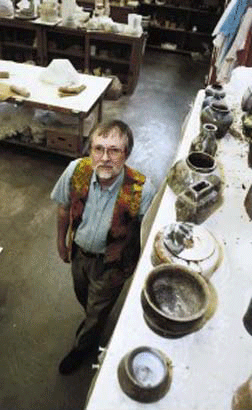News Archives - 2002
Norm Holen: Equalizing the art opportunities
 In 1976, art professor Norm Holen was asked by someone from the registrar's office if he would be willing to work with a physically-disabled student in one of his art classes. “As I started to walk away,” recounts Holen, “this staff person said, ‘I should just mention that he can only move his left foot.’”
In 1976, art professor Norm Holen was asked by someone from the registrar's office if he would be willing to work with a physically-disabled student in one of his art classes. “As I started to walk away,” recounts Holen, “this staff person said, ‘I should just mention that he can only move his left foot.’”
Holen decided to make a tool for sculpture that would fit between the student's first two toes, trying it out first on his own foot. From there, Holen evolved the concept to a kind of wooden sandal, using old belts for straps. The student adapted well to it, and Holen further outfitted the “shoe” with changeable tools and a gummed sole to prevent slippage.
“Sculpture was ideal, because if you did anything other than clay, you needed two hands,” explains Holen. “If you did pottery, you'd have to do the inside. So sculpture was a natural, because you only needed to do the outside.”
Holen’s next challenge was with students who couldn't lift their arms. He developed a canvas bag with sand as a counterbalance, eliminating the need for strength to lift.
“[The student] said that he really enjoyed being in class, because with the first time he could lift his arm. And it was fun, enjoyable, something we take for granted. But it was something he could now do,” recalls Holen.
For one student, Holen's tool was too efficient. The student had regained strength through rehab and wanted to push his capacity, so Holen created a lighter tool that didn't need a counterbalance. Not being able to find anything thin enough, Holen had to laminate his own wood, about 3/16 inch thick, weighing only 10 oz. when finished.
While each of the splints he made took as long as some of his sculptures, Holen never charged students or the College for his work. “All I did was to solve the problem so that they had the tools to work with. I just wanted to make it more consistent, for them to have the same opportunities as everyone else.”
Holen also created a headpiece for a student who was very immobile, who had only head movement and used a breathing apparatus. He designed an adjustable head splint with Velcro and canvas straps for tools that would eliminate the need to hold tools in the mouth—making it easier on the jaws and teeth, and permitting the student to talk during class.
Holen has kept in touch over the years with a number of his students with disabilities. He still talks weekly with Jon Leverentz, a student who suffered brain damage in a car accident. Leverentz needed help opening the caps of his paint tubes, and Holen made a ribbed receptacle that allowed the cap to be held while the tube turned.
In 1990, Holen received the Governors’ Award on Technology to Assist Individuals with Disabilities. In 1995, Holen was honored with an Alumni Achievement Award by his alma mater, Concordia College-Moorhead.
Holen's legacy to Augsburg, however, far exceeds his innovative tools. A number of his sculptures in clay, welded steel, and cast bronze are part of the community and campus—the “Burning Bush” in front of Christensen Center to honor Bernhard Christensen, the Augsburg Seminary seal on the brick wall next to the entrance to Hoversten Chapel, the Hoversten Chapel cross and the bas relief in Sverdrup Hall called “The Promulgation of Learning and Culture.”
When asked about his life work, Holen reports at least 21 one-person shows, 92 group shows, and 116 competitive exhibitions, including a group show at the National Gallery of Art. He says he now concentrates on national or international shows. His achievement includes 16 national and two international awards.
Holen intends to enjoy his retirement time working on his own projects full time. The tools and splints he made will still be available to students who may need them. Holen and his wife, Ilene, have established an endowed scholarship in his name to support art and art history students at Augsburg.